What is Butterfly Pea? – Butterfly pea is a beautiful flowering plant. It is a flowering vine native to tropical Asian and African countries. The specific name butterfly pea is given to this vine due to its beautiful blue or purple flowers, which resembles a small butterfly. Another significance is that a pea-like seed pod develops after fertilization.
Check out my previous post: 6 Tips to keep your Moss Garden Healthy & Beautiful
Scientific Facts about Clitoria ternatea
| Scientific name | Clitoria ternatea |
| Common Name | Butterfly pea, Aparajita, Gokarna, Asian pigeonwing, Blue pea |
| Type | Vine |
| Family | Fabaceae |
| Growing Season | Perineal in Tropical climate, Annual in Colder regions. |
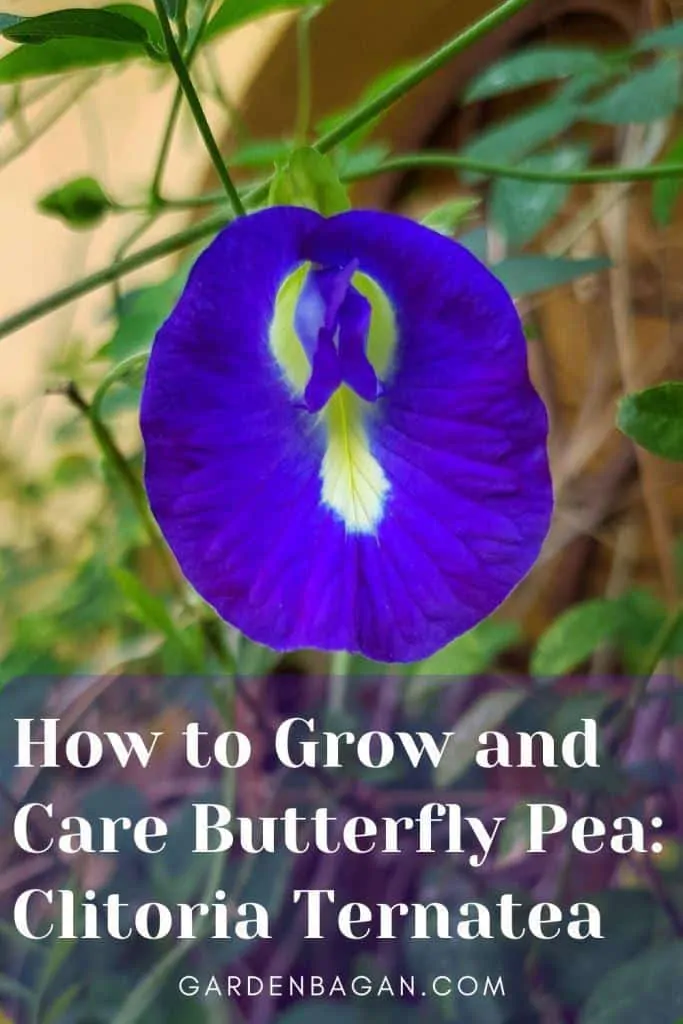
Butterfly pea belongs to the Species “Ternatea” in the Genus “Clitoria” of the family “Fabaceae” and Order “Fabales”. Its scientific name is Clitoria Ternatea.
It has many other common names including Asian Pigeonwings, Aparajita, Gokarna, Blue pea, Cordofan & Darwin Pea.
The Butterfly pea is soft to semi-hardwood Green vine. It has a well defined Fibrous root system. It is a fairly deep-rooted plant.
Butterfly Pea is a native flowering plant to tropical Asian and African Countries like India, Pakistan, Srilanka, Bangladesh, Australia, and so on. Now it is popularly grown worldwide especially for its beautiful flowers and fodders.
Butterfly pea or Clitoria Ternatea is a natural nitrogen fixating plant. It forms nodes in the roots that contain nitrogen fixating bacteria like Nitrosomonas. In recent researches, it is shown that butterfly pea can increase 30 to 35 % nitrogen with nearly 15-22% natural phosphates, potassium, and sulfur to the soil in one year. This plant can be a good alternative for crop rotation.
What are the Types of Butterfly Pea?
| Main Variants | Blue & White Butterfly Pea |
| Other rare Variants | Purple, Light Blue, Pink, Red & Black Clitoria ternatea flowers. |
| Leaf | 2-4 cm in size over a 5-inch leaflet in length. 5-9 elliptical green leaf in each leaflet. |
| Flower | 2-inch in diameter. 5 petals fused to 2/3rd of the length from the bottom. |
Most of you are familiar with the blue butterfly pea flowers. The Blue and White color flowers are common natural variants. Other than these, you can find some purple, pink, or red butterfly pea flowers. But it is quite rare and exotic.
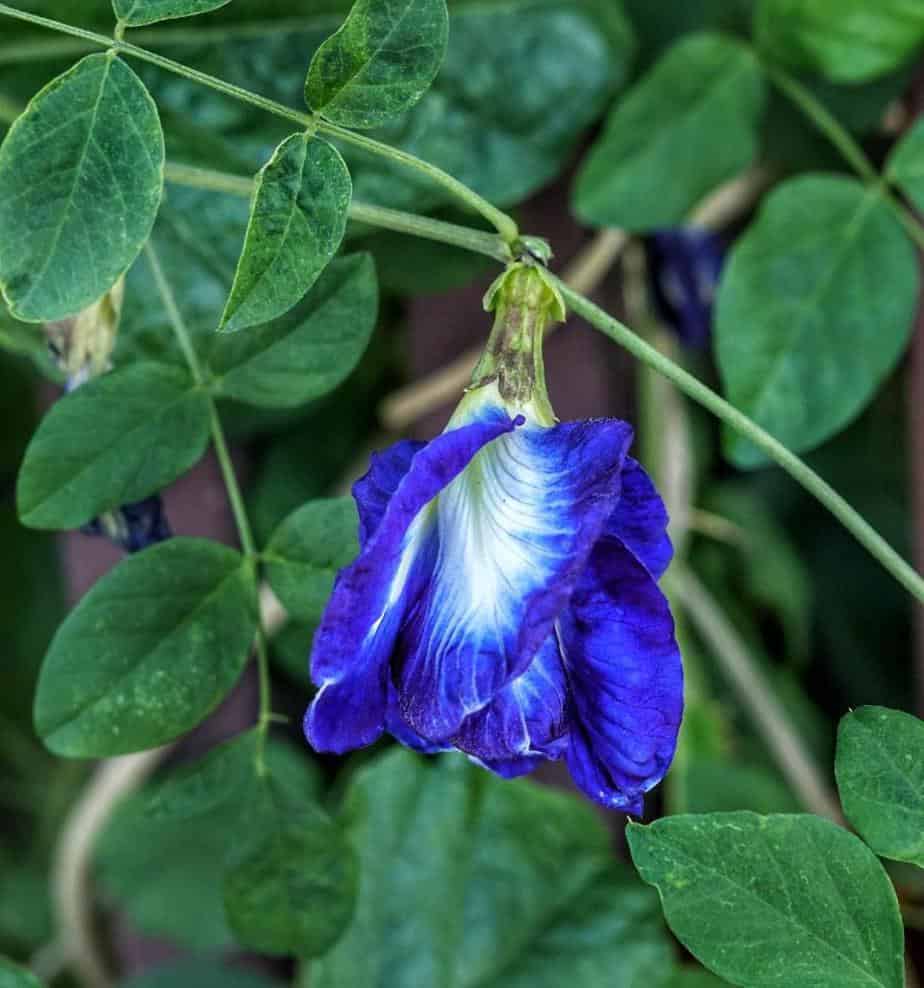
The flowers generally occur isolated. Sometimes you can find them in a bunch of three. There are 5 petals in each flower. 2 curled petals in the center and 3 broad petals in the outer edges.
The central petals cover the anther and stigma. Each butterfly pea flower has a long cylindrical style at the base of petals. This style is fused with the 2/3rd of the bottom length of petals. It contains the ovary with at least 10 eggs. These eggs develop into seeds after successful fertilization.
The leaves of butterfly pea plants are flat broad and nearly 2-4 cm in length. These leaves are grouped in a 5-9 leaf on a single leaflet. Each leaf is distinct and separated from other leaves by a branched leaflet.

Where does Butterfly pea flower grow?
Butterfly pea or Clitoria Ternatea is a native to tropical climate. This means the butterfly pea is comfortable in a hot and humid climate.
USDA zone 11 and 12 is ideal for the growth of butterfly pea. In these regions, the plant grows as a perennial flowering plant. You can grow butterfly pea in Zone 10 and some colder regions. Here you have to maintain and regulate the Clitoria ternatea as an Annual flowering plant.
Being a tropical plant, Butterfly pea can not withstand a heavy frost. Butterfly pea is a perfect drought-resistant plant but you should water these regularly for healthier green look and frequent flowering.
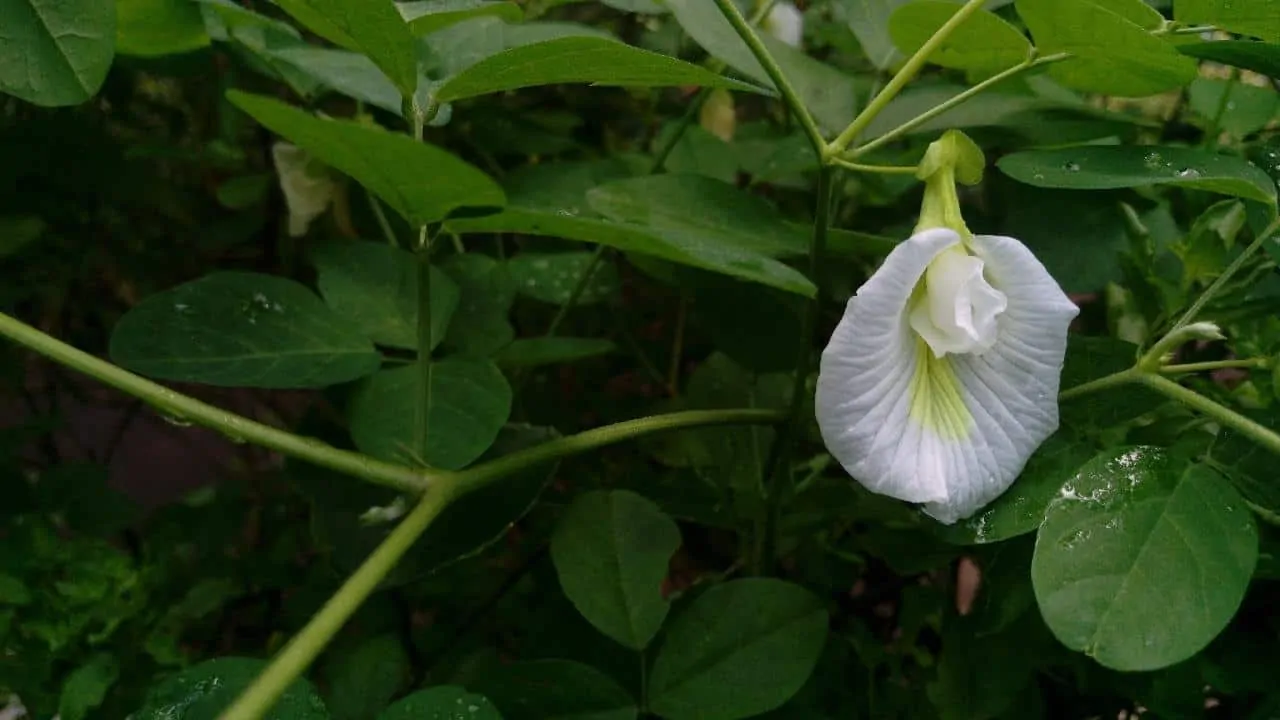
Material required to grow Butterfly pea
- Some Quality Butterfly Pea Seeds.
- Seed germination mix, Potting mix.
- Chicken garden net or thread net for support.
- NPK 19:19:19 for Best blooming
- Pots & Containers at least 6-8 inches deep.
The seed is the most important thing you need. You can collect seeds from mature seed pods or buy some from a seed store. 6-10 month Aged seeds have better germination than freshly collected seeds.
Next, you will need some soil or growing media. The soil mix should be well-drained and fertile. You will need some rope or net for support. A trellis or patola is the ideal support for butterfly pea plants. The beautiful blue and white flowers will make the landscape more colorful and vibrant.
Use a balanced fertilizer like NPK 19:19:19 for flowering plants like Butterfly pea. High phosphorus-based fertilizers are best for Clitoria ternatea.
If planing for container gardening then for butterfly pea take at least 6-8 inch deep pot. These vines are highly tolerant of natural factors like temperature, moisture, and soil condition. So I think wherever you live you can manage a Butterfly pea plant.
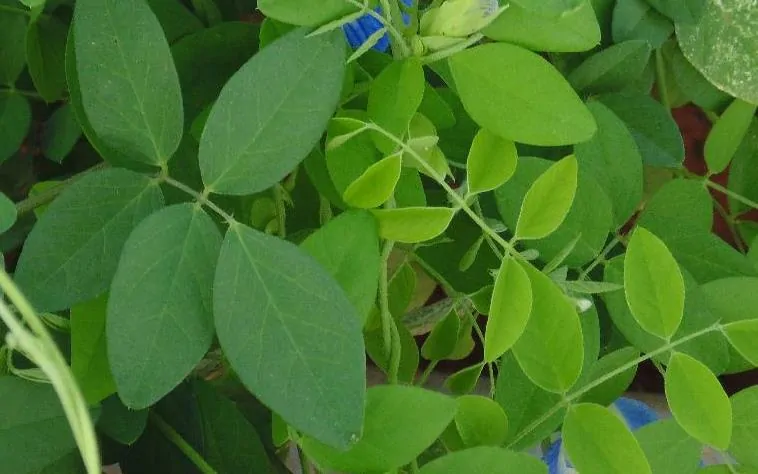
What to Know before growing butterfly pea: Clitoria ternatea
| Hardiness Zone | 11 to 12 (10 optional) USDA |
| Spread | 6 feet |
| Length | 10-15 feet or 3-4 meter |
| Sunlight Requirement | 6-8 hours of Full Sunlight |
| Water Requirement | Medium to Heavy. (Drought Tolerant) |
| Growing Season | Early Spring to Late Summer |
| Growth rate | Fast in a warm tropical climate. Medium to Slow in Colder regions. |
There are a few important things that you should consider learning before planting a butterfly pea.
First is the acclimatization- The butterfly pea or Clitoria ternatea plant is a very hardy drought-resistant plant. So You can easily grow these plants in dry arid regions. They love tropical climate so there’s nothing to fear from heavy rain. These plants can handle low temperature unless it is not freezing low.
In unfavorable climatic conditions like heavy rain or complete drought, the leaves will fall but the plant stem will survive for next season.
These beautiful vines can spread up to 6-8 feet area and grows to 10-15 feet long. Keep in mind these are not small decorative foliage, they can cover a large area. Therefore, you should provide proper support to grow and spread easily.
The best option is to keep the plant near a wall and provide support like chicken net or strings to climb. A singly mature butterfly pea plant can cover an area of 100-150 sq feet. The plants look beautiful and mesmerizing during the flowering season.
Next, you should know that these plants need full sunlight every day for at least 6-10 hours. Butterfly pea flowers can bloom only when the temperature is above 24 degrees Celsius or 70 degrees Fahrenheit.
You can grow these plants indoors but for best bloom, you have to arrange proper lighting. Some gardeners say that butterfly pea needs very little watering. This is not true. In fact, These plants are favorable with heavy rain (600-800 mm). Their only requirement is well-drained soil.
You will see the best result in Clitoria ternatea using well-drained sandy soil with regular watering and fertilization.
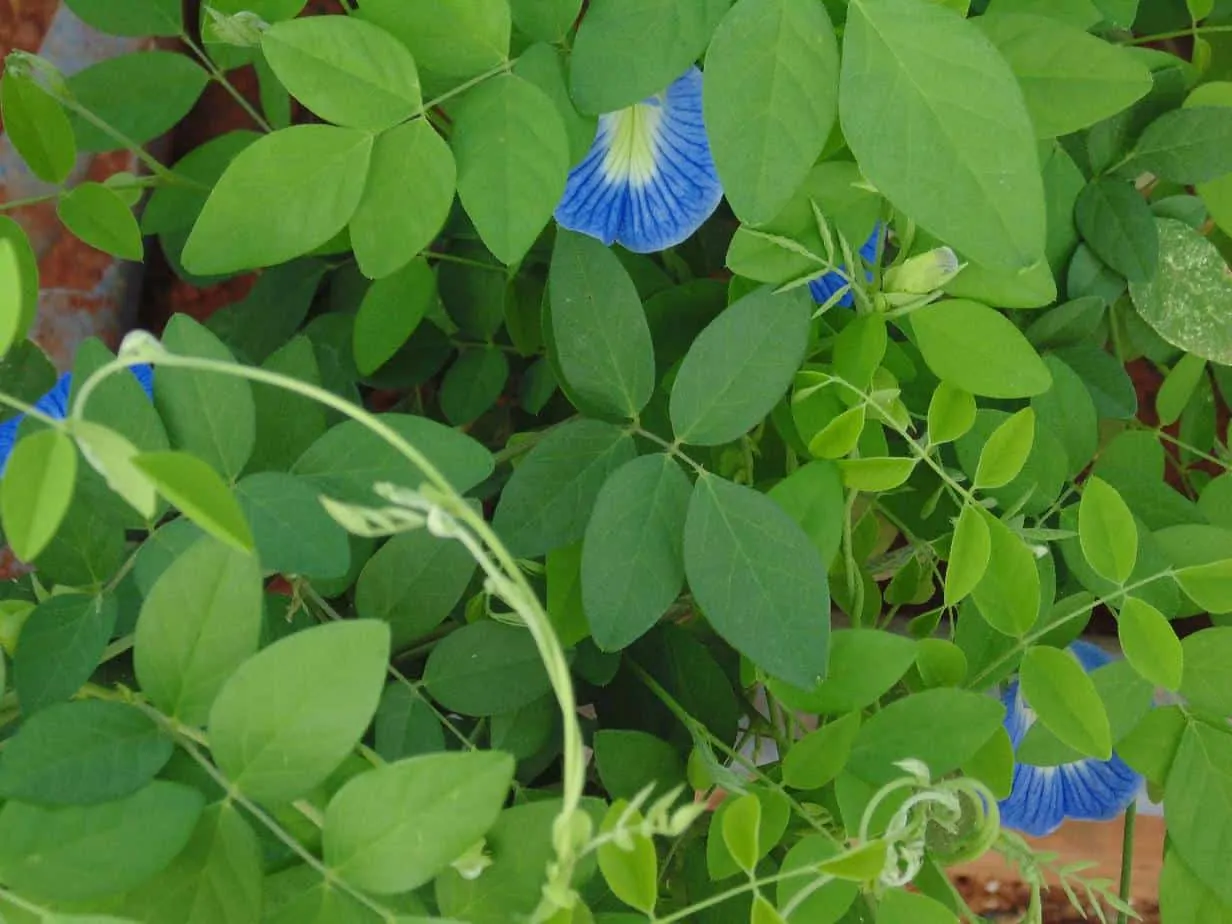
If everything seems fine then get ready for the action.
How to do Soil preparation?
| Soil | Well Drained Sandy Soil |
| Ph Tolerant | 5.5 to 8.9. Very hardy with variable ph. values |
| Fertilizer Requirement | Low to medium feeders |
- Take 1 Part Garden Soil, only topsoil (2-5 cm from the top), 1 Part Sand, 1 Part Compost. You can use perlite and coco peat with this mix.
- Dry fry the soil mix for 10 minutes in 150-200 degrees Celcius. You can simply microwave the soil mix for 10 -15 minutes at medium-high temperature. Coco peat and peat moss will burn at this temperature. So add those after this step.
- Let the soil mix cool down for a few hours.
- At last, add 1-2 teaspoon NPK to this soil mix. Mix everything and sprinkle some water for moisture.
- Leave the soil mix in dark for 2-3 days.
- After 3 or 4 days just mix it well and use for growing seeds or any cuttings.
How to grow Butterfly pea?
| Growing Methods | 1. Growing from Seeds
2. Growing from Cuttings |
| Time to Mature & Bloom | 1. 6-8 months from seed germination
2. 3-6 months after successful rooting and Transplantation. |
| Spacing | 3-4 inch distance between seeds and 10-12 inch (20-30 cm) distance between each plant. |
Butterfly pea or Clitoria Ternatea can be grown from seed as well as from cuttings.
A plant grown from seeds can take up to 1 year to bloom. The plants developed from cuttings will get mature quickly. Hence you can expect to bloom within 6 months.
Growing a butterfly pea plant from seed is easier than from cutting. So Commercial gardeners and nursery owners use the best quality seed for the propagation of butterfly pea plants.
Each plant should be equally spaced from the other. There should be at least a 20-30 cm or 1-foot gap between each plant. The seeds should be spaced at least 4-6inch for the next one.
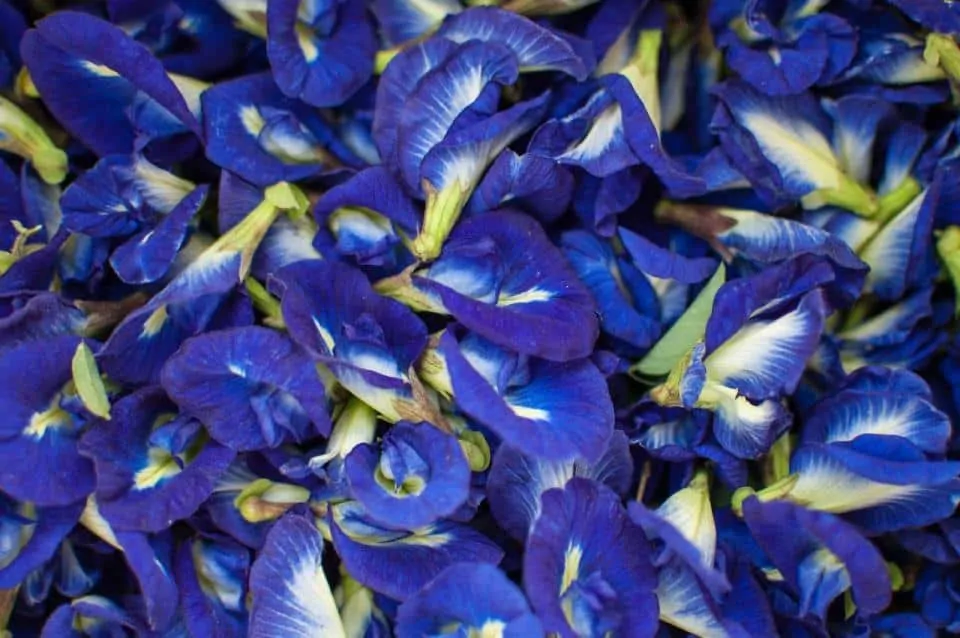
How to germinate Clitoria ternatea seeds?
| Seed Pod | 5-7 cm with 8-10 seeds. Flat Pea shaped Seed pods with pointed tips. |
| Seeds | 2-3mm in size, slightly round in shape. Black & Brown in Color. |
| Soaking Time | 15-24 hours in normal water. 3-4 hours in Luke warm water. |
| Germination Rate | Low to medium |
| Time to Germinate | 15-20 days. 2-4 weeks when the temperature is below 26 degrees Celcius.
10-15 days in 26 to 34 degrees Celcius. |
| Temperature Requirements | Minimum: 25-degree Celcius
Maximum:34- 38-degree Celcius |
| Special Tips | Germinate 4-8 weeks before spring in a warm indoor location.
Use a few drops of Conc. Nitric acid or dill. Sulphuric acid for 10-15 minutes, this will scarify the hard shell for faster germination. |
| Seed Sowing | 2-3 cm below the soil level. Use fertile growing media and soil mix. (Perlite, Peat moss, Cocopeat) |
Seed germination is not always satisfactory with butterfly pea. The rate of germination is lower than other flowering plants. You can directly sow the seeds and it should grow in ideal condition. If unsuccessful, then I am here- follow my tried and tested steps.
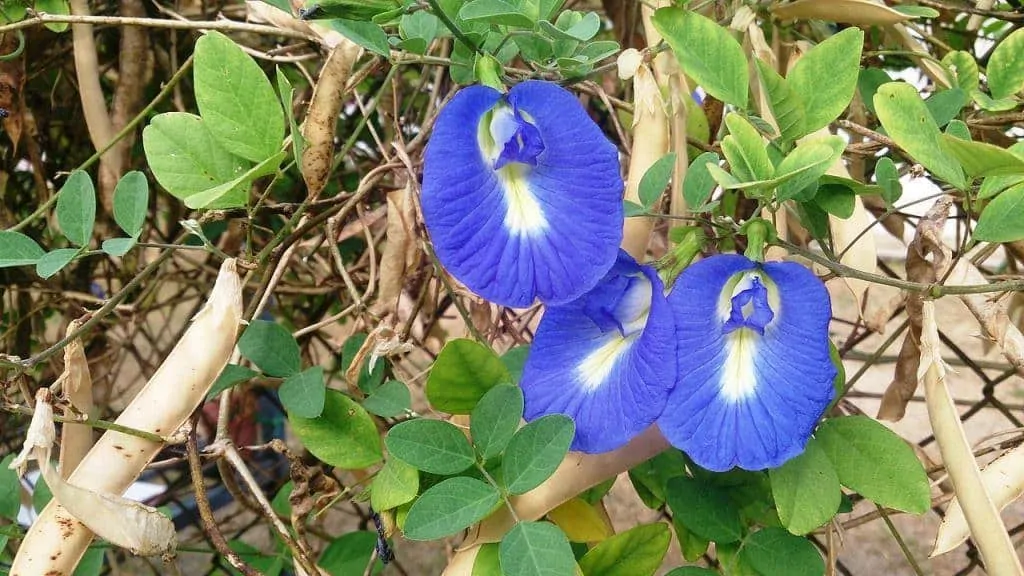
So You should follow the steps carefully for the best results.
- Only choose the healthy seeds for the germination purpose. A healthy seed should be dark brown or black in color.
- It should be round and firm. Just apply some pressure with your fingertips, it should feel hard like a stone.
- Next, check the seeds by putting them in water. The good seed will settle down and rest will keep floating.
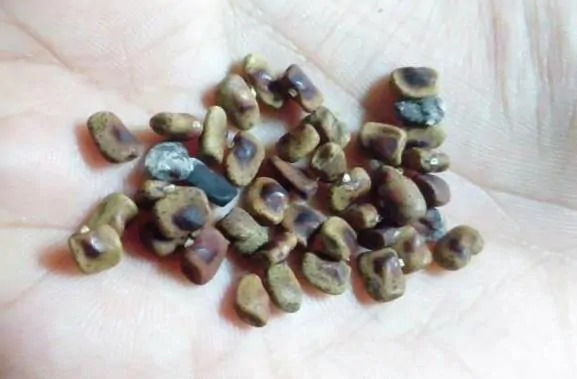
Keep Reading for Seed Germination Steps–
- Soak the seeds in plain drinking water or 10 to 20 hours. You can keep it soaking for a maximum of 24 hours or 1 day. Don’t worry the seed will not rot, they have a hard outer covering that can take up to 36 hours to soak water.
- Scarification is helpful if the temperature is below 26 degrees Celcius or 69 degrees Fahrenheit.
- You can file or scrap the covering of each seed with the help of fine sandpaper. This is a delicate job. Don’t overdo anything. Try not to harm or expose the core entirely.
- You can directly sow the seeds to the ground after 24 hours of soaking.
- An alternative is to keep the seeds in a paper towel for root development for 15-20 days. This will ensure which seed is good and which is not.
- Once germinated, place each seed in growing media. Use soil & cocopeat or the soil mix we have already discussed.
- Make a 1-inch hole in the soil mix. Place the seed carefully in it. Then cover the hole with some soil mix.
- Water the mix with sprayer. Mix 1-2 teaspoons of any contact fungicide with the water, only for the first time.
- Place the soil mix with seed in semi-shade for 3-4 weeks. Careful with the lighting, at least 2 hours light is required for better germination in butterfly pea seeds.
- Keep the soil mix moist. It should not dry for the first 15 days after sowing the seeds. Don’t overwater, seeds can rot in the soggy soil mix. So be careful with watering.
Your butterfly pea plants will be ready to transplant within 30-45 days after germination.
How to grow Clitoria ternatea from cuttings?
| Cutting Size | Minimum: 4-inches
Maximum:8-inches |
| Cutting type | Soft to semi-hard stem cutting required |
| Rooting Aid | No Rooting Hormone required during monsoon season.
In colder region rooting hormone is required for successful root growth. |
Just like seeds, you can also grow butterfly pea using its cuttings. This is a faster method to get a mature plant but it is not that easy. This method will require some keen observational skills. You have to be careful with each step for 100% success.
Don’t worry this is not that difficult. If you are ready for the effort then it’s just a matter of time for successful growth. Keep reading for detailed information.
- Take 6-8 inch healthy cutting for a mature plant. Take some semi-hard word vine for cutting purposes.
- Remove most of the leaves and leaflets from the stem. More leaf means more transpiration. This will reduce the chance of root development. So leaving 2-4 leaves at the top, remove the rest of the leaves from the cuttings.
- Carefully make a 1cm ring from the bottom of the cutting. Don’t break it, just make it round and tuck it inside.
- Apply enough rooting hormone powder over this ring. You can first dip it in water and then to the rooting aid for proper application.
- Dig 2-3 inch deep hole in the same soil mix as discussed above.
- Place each cutting in one hole.
- Separate each cutting from another by at least 6-10 cm.
- Water the cutting using sprayers. Don’t pour water directly.
- Place the cuttings in semi-shade and avoid disturbing for 15-20 days.
- Water regularly whenever required. Touch the soil to test for moisture level.
All the leaves will fall within 10 days but don’t worry new leaves will develop eventually. It can take up to 25 days for the cutting to be ready for transplant.
Growing Clitoria ternatea in containers
| Comfort | Easy to Grow in Containers like Pots & Hanging Baskets |
| Size | Minimum: 6-8 inch container required. |
Clitoria ternatea or Butterfly pea can be easily grown in containers. It is a suitable plant for hanging baskets. You should take at least 6-8 inch containers for these beautiful flowering vines. Bigger pots are better for butterfly pea plants.
The pots & container should have proper drainage holes. Remember Butterfly pea can not withstand or survive soggy soil. Such a situation will lead to root rot and ultimately the death of the plant.
Transplantation of Butterfly Pea
You can transplant the seedlings and saplings of butterfly pea once they have grown 3-4 mature leaves. The ideal size of the plant for transplantation is 3-4 inches.
- Take out the seedlings or cutting carefully from the soil mix. Don’t remove the soil from the root ball. Avoid any damage to the delicate root system.
- You can use the same mix for potting the plants. Butterfly pea Plants can be directly grown in the soil. So if you are ready you can do so. Else keep reading.
- Take a 4-6 inch post for the first transplant. It is recommended to transplant the butterfly pea plant in smaller pots before placing them in bigger containers. This will increase the chance of survival and healthier growth.
- Keep the plant in a small pot for 30-45 days. Fertilize the plants once during this period. Pinch the tip of the vines once in 15 days. 2 successive pinchings can be done during this phase. You can use liquid fertilizer or 1/4 teaspoon NPK 19:19:19 per pot. Fertilization after pinching is a good practice.
- After 2 months move the plants to bigger pots. Remember a mature butterfly rea will need at least 8-10 inch space.
- Again leave the plant in semi-shade for 15 days after transplantation. Pich the tips of the branches once during this time. Pinching will make the plant bushier.
- Place the pots in full sun after 15 or 20 days. Now on you need not worry about the sun, wind, or water for the plant.
- Just water the plant whenever required and fertilize once in a month for greener healthier butterfly pea plant.
Water & Fertilizer Requirements
If you follow the steps of soil preparation then you probably skip any further fertilization. Butterfly pea plants are known to have nitrogen fixating nature. So just potassium and phosphorus-based fertilizer will be enough for these plants.
You can use flower booster available online for the best result with blooming.
Butterfly pea plant can survive in the long dry season so water is not a big problem. But if you let the plant droop regularly then it will not bloom. All its resources will be spent on keeping it alive. Therefore, Always try to maintain proper moisture especially for the greenery.
Problems with Butterfly pea: Clitoria ternatea
| Common Problems | 1. Very Hardy. Not prone to any Special Problem. 2. White Fly 3. Spider mites 4. Aphids 5. Root Rot due to fungal attack. |
Butterfly pea or Clitoria ternatea is not prone to any serious diseases. It is only affected by the fungal root rot diseases. This is only due to the problem of waterlogging. If you control the water logging problem then it will be easily managed.
The next common problem is whitefly & aphids or spider mites. A simple water jet or alcohol rub is enough to handle these pests. So no need for any chemical pesticides.
Alternatively, you can use a soap water solution to get rid of these pests. You should read Common Succulent Problem: 6 Pests and their treatment
How to care Butterfly pea plants?
| Pruning | Regular Pruning required after every flowering season. |
| Deadheading | Not Compulsory. Recommended keeping the plant green and bushier. Deadheading also increases the rate of blooming in Butterfly pea. |
Prune the plant 45 days before and 10 days after each flowering season. This will keep the plant ready for blooming. Always fertilize the plant after each pruning session. You can use the cut pieces for re-growing new plants.
During the flowering season, you should deadhead the dead and spent flowers and branches. If you leave the flower to mature & dry, then it will develop seeds. More seeds mean less flowering. So Remove dead flowers during the early flowering season. If you want to grow seeds then leave only some that you can count on.
Special tips for Clitoria ternatea
- Once it is grown, You need not spend any time for caring this plant.
- Make some trellis or net to provide support to the butterfly pea plant.
- Use sandy soil with compost for hanging baskets.
- Organic mustard cake powder or cow dung powder is enough to fertilize butterfly pea plants.
- Place the plant in direct sun in colder regions. In a more warm and hotter climate place your plant in semi-shade. This will keep your plant green and full of blooms.
Final Words
D you Know?- The beautiful Blue Butterfly pea flower is also used for making edible die and herbal tea. Some recent research in rats shows the capacity of butterfly pea to improve memory.
It is also used as a fodder crop in countries like Australia. Some research indicates its viability for the preparation of medicines especially antioxidants, anti-inflammatory, and analgesic drugs. More research needs to be done in this field.
I hope this post is helpful for you to grow the butterfly pea plant. If you have any questions, suggestions, or any interesting story to share then comment below.
I’ll be back with something more interesting. Till then Keep reading keep gardening.

Very informative article. The best I have found in this plant. Thank you for sharing
This is the most helpful and comprehensive guide to growing blue butterfly peas that I have found! Thank you for your clear instructions and detailed information.
My leaves are turning light green, it’s looking very pale. What is going wrong?
Low light and lack of nitrogen, Magnesium, and zinc can lead to yellowing of leaves. Don’t worry move the plant in full sunlight if possible. Then add 1 teaspoon dry coffee powder and 2 spoons of compost to the soil. Always water after fertilization. Repeat this step once every 15 days and it will do the job. You can use Urea but it is chemical fertilizer and need some extra care. Do share the results and feel free to ask anything about gardening.
Thanks for the article about the butterfly pea plant. Very informative and detailed.
Hi, I’m in zone 8b where it would need to be grown as an annual. But can I bring it inside during the cold months to keep it alive? Would I need a grow light? Thank you.
Yes, definitely you should bring it inside during cold months. Especially in Zone 8, you must grow butterfly pea in light movable containers. It is for convenience during seasonal shifts. you can use grow light if natural light is not sufficient, normal indoor lights will also work. Just keep the plant warm and well-lit throughout winter.
Does blue butterfly pea come back after winter time??? Thanks!
Yes, Blue or White, in fact, all types of butterfly pea can survive the winter. Though you have to keep it safe from frost and snow. It is a warm-weather plant so a better option is to move the plant indoors during winter. It will need warmth and proper light to survive and yes, don’t expect flowers during winter. Good luck, Keep Gardening!
Nice article, but I need answer for aparajita plant care after winter, since it is a perineal plant, will it grow back? How?
yes, It will grow back and there is no need for heavy pruning. Only keep the plant safe from heavy frost or snow if it is the case. Fertilize early in the fall and leave the Aparajita plant to acclimatize with decreasing temperatures. It is a hardy plant so survival should not be a problem. Good luck and keep gardening.
Hi, nice article. I live in Singapore. My blue pea plant leaves curl inwards and droop downwards. This happen 1 week after I bought the plant. The initial 3 to 4 days were ok with blooms. I placed it on my balcony where there is ample sun from morning to noon. Pls help to advise
Inward leaf curling can happen in blue pea due to dehydration as well as transplant shock. If the plant is well established without any shock then check for soil drainage. Keep the soil light and moist but not damp. If possible add a little bit of compost in it for slow feeding. take care and don’t worry these plants are very resilient and they will survive little problems.
I live in florida and I was wondering if deer eat these as we are surrounded nightly by our neighborhood deer.Do I need to protect them from deer?Thank you
Butterfly pea is not the first preference for deers. They won’t eat it unless there is nothing else to graze on. Deers may leave these vines after a few bites although they may like the taste of the seed pods. So this should not be a big problem. If you are unsure then installing a fence or a few rolls of chicken wire would do the job.
If planted in a container, can it be hung with strings/wires to allow the vine to cascade downward? If I choose to grow it this way, any other suggestions or advice?
The butterfly pea is a really hardy plant. It can sustain any situation whether it is a pot or a hanging basket. All you need is to keep it well-fed; a little moisture every week will keep it healthy and flowering for years. I got one white butterfly pea plant on my terrace since 2017 and it’s still blooming well. So give it a try with some strong wire, and keep it hanging.
Thank you sukant, very informative. nevertheless, i wanted to know which flowers are dried, e.g., is it only the single petalled / double petalled blue colour ones only or any colour would be ok
A dry butterfly pea will shrink and fade off on its own. If the flower is properly pollinated, then it will develop a seed pod that looks much like a flat green pea pod but is smaller in size. The drying process is similar, irrespective of the color and variety of these flowers. The seed pod will turn yellow and then brown while drying.
I didn’t pick the flowers of my robust butterfly blue pea so now there are multiple seed pods and flowering has stopped, and the leaves are drying up along with the browning of the pods. Should I wait for the pods to pop, then cut off all the branches so that new branches can emerge and flowering can start again?
You should collect some healthy mature seeds especially if the mother plant is diseased. On the other hand, if flowering is stopped and the plant seems unhealthy then it’s better to cut off extra foliage and save as much seed as possible. Also, feed the plant with natural fertilizers and something rich in nitrogen to encourage new leaves and branch growth. A spoonful of used tea leaves or coffee grounds with plenty of water should help. You can also feed it with some phosphorus and potassium based flower food.